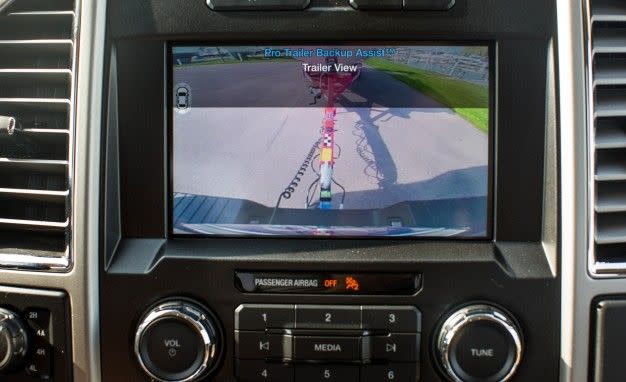2016 Ford F-150 Can Back Up a Trailer For You


Reversing with a trailer is a skill that ranks right up there with operating a manual transmission: Most people have never tried it, plenty of folks who have are awful at it, and those who have mastered it can elicit a sense of awe from onlookers and companions. And just as driving a stick-shift Dodge Viper differs greatly from piloting a manual Honda Fit, no two vehicle-and-trailer rigs are the same. Hills can be a big challenge, too, and for God’s sake don’t jackknife.
That’s a lot to think about for those who hitch up only a few times per year. Ford wants to simplify this matter for customers of its bestselling F-150, and so, for the 2016 model year, the company is rolling out Pro Trailer Backup Assist (PTBA). In the spirit of electric-power-steering systems that take over steering duties to help drivers park their cars, Ford’s new feature provides a hands-off solution to trailer reversing. In the case of PTBA, however, the driver lets go of the steering wheel and grabs a dashboard control knob labeled Trailer Backup.
We had a brief backwards test-drive and found the system to be quite intuitive, particularly when monitoring the trailer through the truck’s sideview mirrors: If you want the trailer to go a little bit to the left, release the steering wheel, then turn and hold the dashboard knob a little bit to the left and operate the pedals as normal; with PTBA active and reverse selected, the truck limits vehicle speed to between 1.9 and 4.3 mph (3 and 7 km/h), depending on how much steering angle is required. Need the trailer to go sharply to the right? Crank the knob to the right as far as it’ll go—which is at 3 o’clock on the dial—and hold it there. Gotta back your trailer down a long, straight driveway? Leave the knob in the 12 o’clock position and ease on back.
Just like a steering wheel, the knob is sensitive, so careful, deliberate movements are important—even though your inputs often result in the truck’s actual steering wheel whizzing around on its own like a thing possessed. The system turns off automatically once you crest 25 mph with the gearshift in drive. Next time you need to use it, just push in on the knob to reactivate PTBA. There’s still some skill involved—for instance, you have to “lead” the trailer a bit and pay careful attention to where the truck and trailer are heading—but it simplifies the entire task.

Trailers come in as many shapes and sizes as cars, so F-150s with PTBA have the ability to save up to 10 trailers in their Sync 3 interface. In a roughly 10-minute process, four different measurements must be inputted prior to getting the system to work as designed with any given trailer:
license plate to hitch ball
tailgate to center of axle(s)
rearview camera to sticker target
center of hitch ball to sticker target
What’s a “sticker target”? It’s the black-and-white checkerboard thing on the tongue of the trailer that’s visible in some of these photos. It’s key to getting this whole system to work, and Ford will provide six of these “engineered stickers” with the purchase of every PTBA-equipped F-150. The arrangement is so adaptable that the Ford engineers who worked on this project say that every trailer they’ve tested—from supershort cement-mixing trailers to extralong car-hauling flatbeds—works with PTBA, so long as there’s a place for the sticker and the trailer is within the F-150’s towing capacity (which ranges from 7500 to 12,200 pounds). Gooseneck trailers won’t work, but maybe they’ll be accommodated for in the next-generation F-series Super Duty.
An in-house-developed system that Ford has been working on in earnest for about eight years, Pro Trailer Backup Assist will be available on every F-150 trim level. It comes standard with the towing package on XLT through Platinum; base XL trucks can get the towing package sans PTBA, but it is available on that trim level, too, necessarily bundled with the backup camera. The towing package costs $695 on 2015 F-150s, so that price will rise a bit with the PTBA.
2015 Ford F-150 battles Chevrolet Silverado 1500, Ram 1500, and Toyota Tundra
Technology: Google’s Self-Driving Car Begins Public Road Testing this Summer
Ford F-150 Full Coverage: News, Photos, Specs, Reviews, and More
Ford engineers, by the way, say that they tested the Volkswagen Group’s comparable trailer-reversing system, available in the new Audi Q7 and the Euro-market Passat. Ford claims that the F-150’s approach is superior because VW’s won’t permit hitch balls of different sizes and heights and that it also doesn’t have presets for trailers, which adds setup time to each reversing session. The folks from Dearborn also don’t believe that prototype remote-control trailer-reversing systems where the driver stands outside of the car, like this one from ZF and Bosch, will reach production or be legal for use any time soon.
The only other update for the ’16 F-150, which was brand-new for 2015, is the addition of a prep package for the truck to run on compressed natural gas. The 2016 Ford F-150 goes on sale at the tail end of this calendar year.

You Might Also Like

 Yahoo Autos
Yahoo Autos 